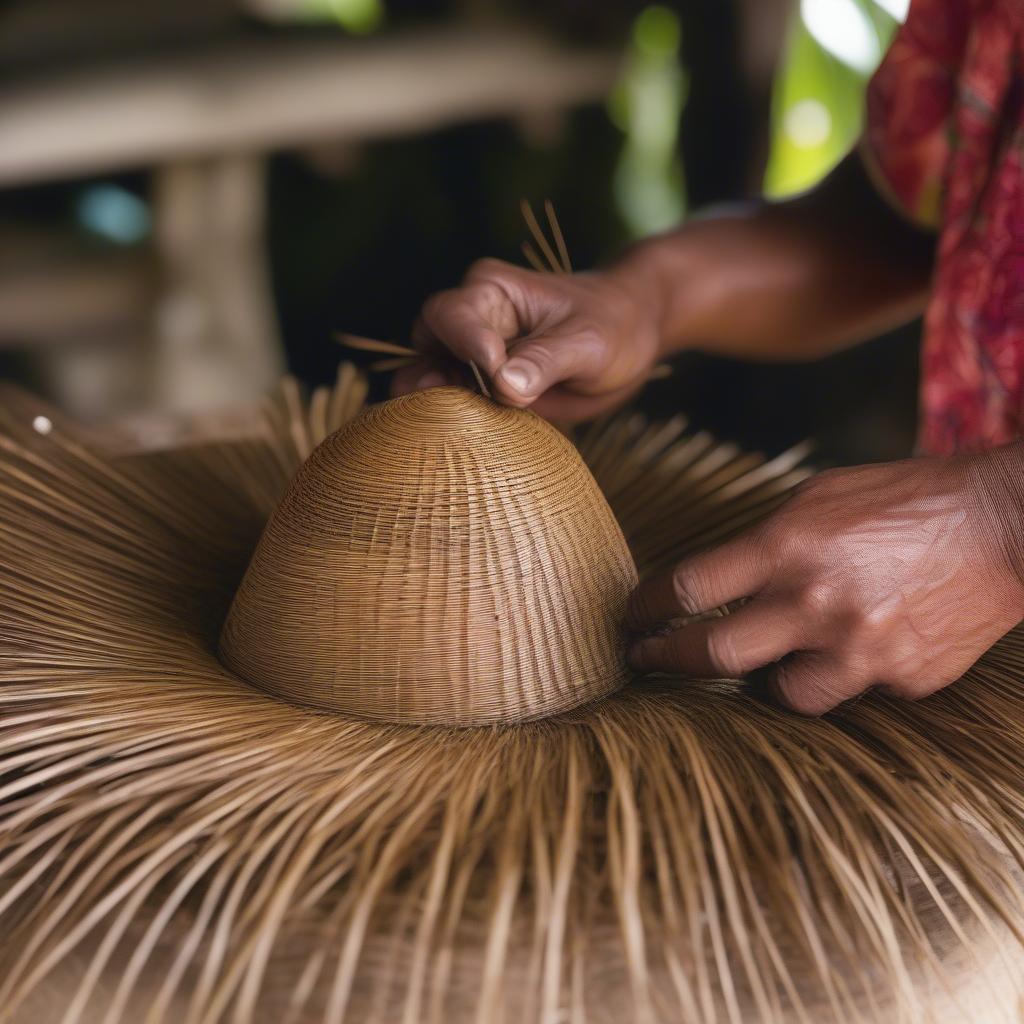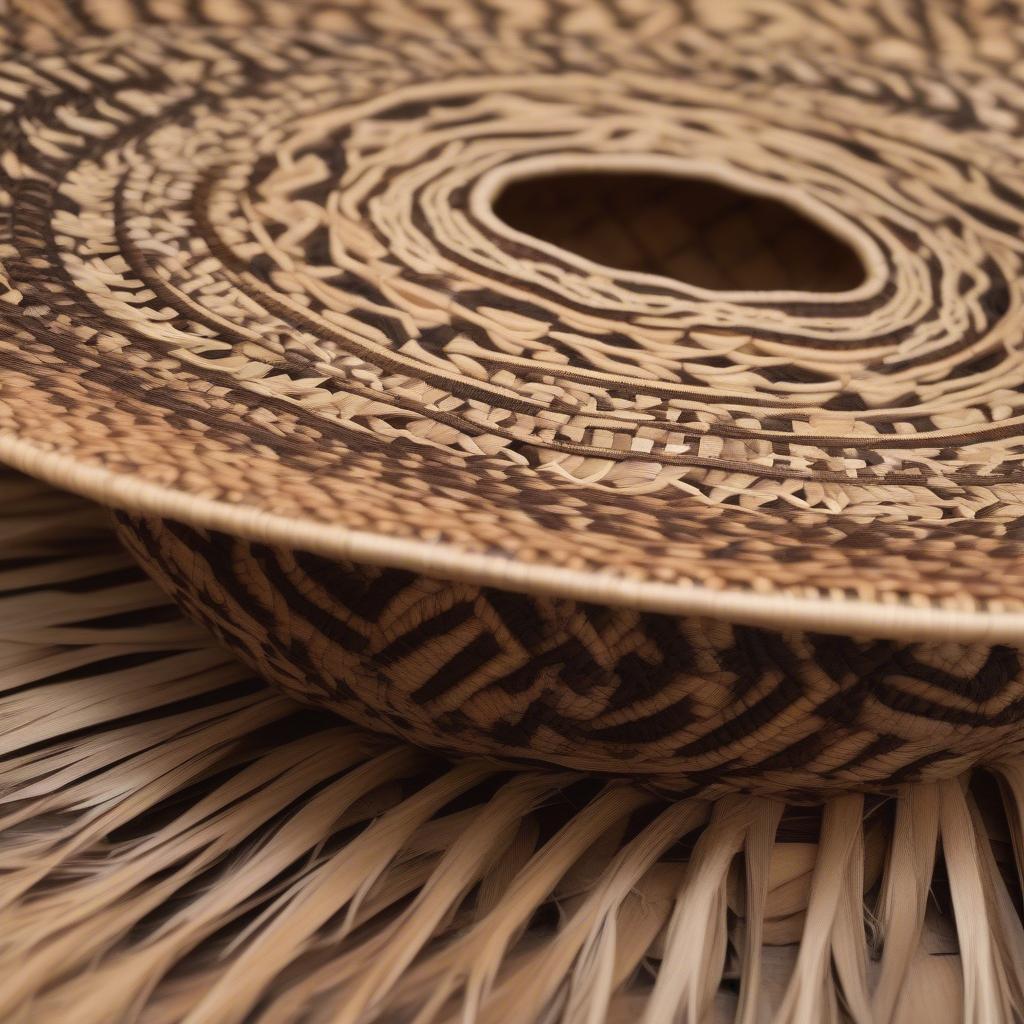Weave Hat
The Art of Coconut Hat Weaving: A Journey from Palm to Protection
Coconut Hat Weaving is a time-honored tradition, transforming humble coconut leaves into iconic symbols of sun protection and cultural heritage. This intricate craft showcases the ingenuity and artistry of artisans worldwide, each hat a testament to their skill and dedication.  Artisan Weaving a Coconut Hat
Artisan Weaving a Coconut Hat
From Frond to Fiber: Preparing the Coconut Palm
The journey of a coconut hat begins with the selection of the perfect palm leaves. Mature, green leaves are carefully chosen for their strength and flexibility. These leaves are then dried, often under the sun, which bleaches them to a lighter color and enhances their durability. After drying, the leaves are expertly split and smoothed, preparing them for the intricate weaving process. This meticulous preparation ensures the final product is not only beautiful but also resilient enough to withstand the elements. Imagine wearing a piece of art that’s also incredibly functional – that’s the magic of a coconut hat.
Weaving Wonders: Techniques and Traditions
 Intricate Patterns on a Woven Coconut Hat
Intricate Patterns on a Woven Coconut Hat
There are various techniques employed in coconut hat weaving, each resulting in unique textures and patterns. Some artisans use a simple over-under weave, while others incorporate more complex patterns, creating intricate designs that tell stories and reflect cultural heritage. These techniques, passed down through generations, are a testament to the enduring legacy of this craft. One popular style is the loose weave palm leaf hat, offering breezy comfort. The tight, precise movements required in coconut hat weaving are almost meditative, transforming simple materials into works of art.
Variations on a Theme: Exploring Different Styles
From the wide-brimmed nón lá of Vietnam to the conical hats of East Asia, coconut hats come in a fascinating array of shapes and sizes. Each style reflects the unique needs and cultural aesthetics of the region where it’s crafted. For instance, the pointed shape of some hats is designed to effectively channel rainwater, while the broad brims of others offer maximum sun protection. These variations highlight the adaptability and versatility of coconut palm as a material.
The Enduring Appeal of Coconut Hats
Why do coconut hats continue to captivate us? Perhaps it’s their connection to nature, the tactile beauty of their woven surfaces, or the sense of history they evoke. Or maybe it’s the simple elegance of their design, providing both shade and style. Whatever the reason, these handcrafted treasures are more than just headwear; they’re a symbol of sustainable craftsmanship, cultural heritage, and timeless appeal.  Woman Wearing Coconut Hat on the Beach
Woman Wearing Coconut Hat on the Beach
How Long Does it Take to Weave a Coconut Hat?
Weaving a single coconut hat can take anywhere from a few hours to several days, depending on the complexity of the design and the skill of the artisan. This time-intensive process contributes to the value and uniqueness of each handcrafted piece.
Are Coconut Hats Eco-Friendly?
Absolutely! Coconut hats are a prime example of sustainable craftsmanship, utilizing a readily renewable resource – the coconut palm. This makes them an environmentally friendly alternative to mass-produced hats made from synthetic materials.
The Future of Coconut Hat Weaving
The future of coconut hat weaving lies in balancing tradition with innovation. While preserving traditional techniques is crucial, incorporating new designs and expanding market reach can help ensure this craft thrives for generations to come. By supporting these artisans, we not only celebrate their artistry but also contribute to the preservation of a valuable cultural heritage. Interested in other natural fiber crafts? Learn about palm hat weaving.
In conclusion, coconut hat weaving is a testament to human ingenuity, transforming simple natural materials into functional works of art. From the careful selection of palm leaves to the intricate weaving techniques, each step in the process reflects a deep respect for tradition and a commitment to sustainable craftsmanship. So, the next time you admire a coconut hat, remember the skilled hands and rich cultural heritage woven into its fibers.
FAQ
- What are coconut hats made of? They are crafted from the leaves of the coconut palm.
- Where are coconut hats traditionally made? They are made in various tropical regions around the world, including Southeast Asia and parts of South America.
- How do I care for my coconut hat? Avoid prolonged exposure to direct sunlight and moisture to maintain its shape and color.
- Can coconut hats be repaired? Minor damage can often be repaired by a skilled weaver.
- Are all coconut hats the same size? No, they come in a variety of shapes and sizes.
You might also be interested in learning about other types of woven hats, such as straw hats or raffia hats. Explore more articles on our website for a deeper dive into the world of handcrafted headwear.
When you need support, please contact our Hotline: +84 388 951 999, address: Hanoi, Vietnam or Tech Avenue, Suite 12, San Francisco, CA 94105, USA. We have a 24/7 customer service team.
